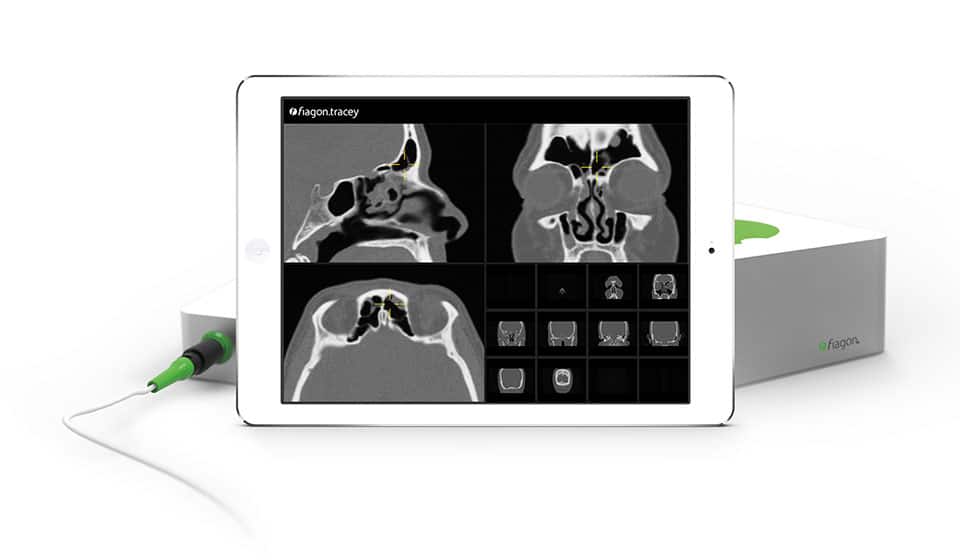A nasal endoscope is a camera with a thin fiberoptic light and magnification attached. During a sinus surgery or procedure, this instrument is used to provide a detailed look at the nasal anatomy, central airway and posterior (further back) aspects of the nasal and sinus passage. A nasal endoscopy allows physicians to safely and effectively apply necessary surgical techniques.

Image guidance is another tool to further assist during a sinus procedure. Image guidance is found in nearly every hospital and surgery center in the country and is similar to GPS in our cars.
It works in conjunction with a patient’s CT scan to provide precise locations or mapping of the nasal and sinus cavity. Since every patient’s anatomy is unique, image guidance removes the guesswork as it pertains to anatomy location, allowing the physicians to provide optimal care.
The St. Louis Sinus Center was the first practice in the region to bring Image Guidance to the office. Having this cutting-edge care on-site, allows us to provide sinus procedures in the office versus having to go to the surgery center or hospital. This is not only convenient, but provides a quicker recover time – allowing patients to get back to enjoying life!
How accurate is image guidance?
Safety is a primary priority due to the anatomical relationship between the sinus cavities, nasal passages, and the eyes. Image guidance during endoscopic sinus procedures significantly enhances the accuracy of the visual field. Because images are observed in real-time, the doctor is kept well aware of updates to the sinuses during surgery. During procedures, a sophisticated software program links CT scan images to surgical instruments via an electromagnetic tracking system. This connection enables the doctor to observe the exact location of diseased tissue or blockages and then correlate their location with vital structures. Current clinical evidence supports the use of image guidance to reduce intraoperative complications and thus maximize patient outcomes.
Does image guidance cause any pain?
Sinus procedures are performed in the office using an analgesic nasal spray. This medication numbs the nasal passageways and may also numb the mouth and throat. The numbness may make it somewhat difficult to swallow, which can feel odd. When the endoscopic instruments are inserted through the nose to the sinus cavity, patients may experience a sense of pressure. This is generally not described as painful. The digital imaging that guides endoscopic procedures is a noninvasive comparison of previous CT images with real-time mapping of structural anatomy. It, therefore, does not add to the existing sensations the patient feels.
What are the most common procedures image guidance is used for?
Image guidance is a beneficial tool for sinus surgeons as it allows for greater accuracy in observing internal structures and anatomy. The doctor may utilize this technology when evaluating a patient for nasal polyps, obstructions, and other conditions.
Is image guidance done during a sinus procedure?
Yes. Image guidance is an intra-operative technology that provides the doctor with accurate mapping of the nasal passageways, sinus cavity, and surrounding structures.
How does image guidance compare to traditional guidance systems?
According to studies, image-guided sinus surgery provides the surgeon with real-time localization of endoscopic surgical instruments by way of a three-dimensional map of the surgical area. As a result of using image guidance, the surgeon may perform with enhanced confidence, safety may be improved, and surgical outcomes maximized through the precise removal or treatment of diseased tissue. It is especially advantageous in revision surgeries and cases involving distorted anatomy or extensive disease. Studies also indicate that, while image guidance technology can take additional time for setup and registration, the additional time was offset by reduced surgical time. While research does suggest that sinus procedures can be improved via image guidance, it must be said that technology is not a substitute for in-depth anatomical knowledge. Patients should obtain sinus care from an appropriately board-certified specialist with direct experience performing sinus procedures.
FAQs
How Should You Prepare for a Sinus Procedure That Uses Image Guidance?

What Should You Expect During the Image-Guided Procedure?
You’ll be lying back while your doctor uses a specialized camera and tools that work in sync with the image guidance software. It’s precise, controlled, and efficient. You will be awake and very comfortable during the procedure and the doctor will communicate with you throughout the procedure to inform you about what to expect.
How Long Does a Typical Image-Guided Sinus Procedure Take?
Most procedures take about 30 mintues to 1 hour. It's not an all-day affair, and many patients are surprised at how quickly it's over.
What Does Recovery Look Like?
You can expect some nasal congestion and mild pressure for a few days. Most people feel well enough to return to work or school the next day, though complete healing may take a couple of weeks.
How Soon Can You Get Back to Normal Life?
Light activities are usually okay within a couple of days. Most folks are back to normal activities in 1 or 2 days but are restricted from strenuous activities during that time. Your our provider will guide you based on how you’re healing.
Are There Any Activity Restrictions After the Procedure?
Avoid heavy lifting, intense workouts, or blowing your nose too hard for a few days.
Are There Any Side Effects or Risks?
All surgeries come with some risk, but image guidance significantly lowers the chance of complications. Side effects may include light bleeding, temporary congestion, or mild discomfort.
Can Image Guidance Be Used for Chronic Sinusitis?
Absolutely. It's especially helpful in chronic sinusitis cases because it ensures precise targeting of problem areas, even in complex anatomy.
Is Image Guidance Used in Both First-Time and Revision Surgeries?
Yes. In fact, it's even more valuable during revision surgeries where things can get a little more unpredictable.
Who Operates the Image Guidance System?
Your board-certified ENT specialist is in full control of the system throughout the procedure, using it to guide every move.
Will You Need a Follow-Up?
Most likely, yes. A follow-up ensures you’re healing well and allows your doctor to make any adjustments to your care plan. It’s quick, easy, and definitely worth it.
Why Should I Choose St. Louis Sinus Center?
When it comes to your sinuses, you deserve expert care with a personal touch. At St. Louis Sinus Center, you’ll get advanced image-guided technology, experienced ENT specialists, and a team that truly listens. From first-time procedures to revision surgeries, they’ve got you covered every step of the way. You’ll also benefit from a caring, results-driven team that tailors every treatment to fit your lifestyle and long-term sinus health goals.

